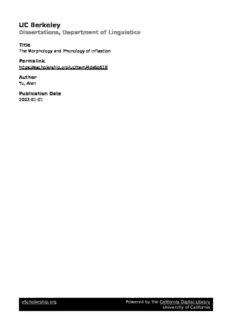
The Morphology and Phonology of Infixation by Alan Chi Lun Yu BA PDF
Preview The Morphology and Phonology of Infixation by Alan Chi Lun Yu BA
UC Berkeley Dissertations, Department of Linguistics Title The Morphology and Phonology of Infixation Permalink https://escholarship.org/uc/item/4ds6q618 Author Yu, Alan Publication Date 2003 eScholarship.org Powered by the California Digital Library University of California The Morphology and Phonology of Infixation by Alan Chi Lun Yu B.A. (University of California, Berkeley) 1998 M.A. (University of California, Berkeley) 1999 A dissertation submitted in partial satisfaction of the requirements for the degree of Doctor of Philosophy in the GRADUATE DIVISION of the UNIVERSITY OF CALIFORNIA, BERKELEY Committee in charge: Professor Sharon Inkelas, Chair Professor Andrew Garrett Professor Johanna Nichols Professor Juliette Blevins Fall 2003 Reproduced with permission of the copyright owner. Further reproduction prohibited without permission. The Morphology and Phonology of Infixation Copyright 2003 by Alan Chi Lun Yu Reproduced with permission of the copyright owner. Further reproduction prohibited without permission. ABSTRACT The Morphology and Phonology of Infixation by Alan Chi Lun Yu Doctor of Philosophy in Linguistics University of California, Berkeley Professor Sharon Inkelas (Chair) The subject matter of this study is the formal properties of infixes. This study begins with a catalogue of the placement properties of infixation in Chapter 1, showing that there is a bias for infixes to target edge constituents. This edge bias is explained in Chapter 4 in terms of the Exogenesis Theory of Infixation, which advocates the view that edge infixes originate from historical prefixes and suffixes; an infix’s original peripheral position is reflected in its edge profile today. A synchronic theory of infixation, Generalized Phonological Subcategorization (GPS), which allows non-prosodic units to enter into subcategorization relations, is proposed in Chapter 2 to encode the subcategorization requirement of an infix. Past theories of infixation are reviewed also in Chapter 2, with particular attention focused on the Hybrid Models which account for the prominence- driven infixes in terms of Prosodic Subcategorization while promoting Displacement Theory (DT) as a mean to explain the distribution of the edge-oriented infixes. Arguments on both theoretical and empirical grounds are summoned against DT’s view 1 - - Reproduced with permission of the copyright owner. Further reproduction prohibited without permission. that edge infixes result from the movement of an underlying prefix or suffix acquiescing to certain phonological or morphological constraints. I advance the Subcategorization Non-violability Hypothesis, epitomized in the universal constraint ranking schema, » P, in Chapter to supplement GPS by restricting the way morphological M align 3 subcategorization requirement interacts with phonological constraints in the grammar; coerced affix movement (i.e. DT) is ruled out by virtue of the fact that constraints on morphological subcategorization must outrank all phonological constraints. Other typological aspects of infixation are reviewed in Chapter 5. 2 - - Reproduced with permission of the copyright owner. Further reproduction prohibited without permission. To my parents i Reproduced with permission of the copyright owner. Further reproduction prohibited without permission. Table of Contents Chapter 1: Introduction......................................................................................................1 1.1 Locating the infixes: A typology of infix position.................................................5 1.2 Introductory exemplification....................................................................................9 1.2.1 First consonant.................................................................................................12 1.2.2 First vowel........................................................................................................19 1.2.3 Final syllable....................................................................................................32 1.2.4 Final vowel.......................................................................................................35 1.2.5 Stress and related metrical units.....................................................................40 1.2.6 Other potential pivots......................................................................................45 1.2.7 Infixation in word games.................................................................................50 1.3 Summary....................................................................................................................54 Chapter 2: Theoretical approaches to infixation........................................................ 58 2.1 Infixation as Phonological Subcategorization.........................................................60 2.1.1 GPS as a unified account of infixation...........................................................62 2.1.2 Evidence of non-prosodic units in phonology...............................................66 2.1.3 Pivot peripherality...........................................................................................71 2.1.4 P-affixation vs. Genuine Infixation................................................................73 2.2 Displacement Theory: A critical analysis...............................................................78 2.2.1 Derivational DT............................................................................................. 79 2.2.2 Optimality Theoretic DT.................................................................................81 2.2.2.1 On the explanatory#alue of Displacement Theory...........................82 ii Reproduced with permission of the copyright owner. Further reproduction prohibited without permission. 2.2.2.1.1 The case against Strong Explanatory Hypothesis......................82 2.2.2.1.2 The case against the Weak Explanatory Hypothesis................86 22.2.2 Under-generation: Empirical inadequacy of DT...............................93 2.2.2.3 Hyperinfixation: a problem of over-generation...................................103 2.3 Conclusion.................................................................................................................106 Chapter 3: Case studies.................................................................................................... 108 3.1 Atayal active indicative infixation...........................................................................109 3.1.1 Introduction......................................................................................................110 3.1.2 Analysis............................................................................................................113 3.1.3 Conclusion........................................................................................................120 3.2 Homeric infixation in English..................................................................................120 3.2.1 The basic pattern..............................................................................................121 3.2.2 Non-peripherality of Homeric infixation ...............................................125 3.2.3 Reduplication in Homeric infixation..............................................................134 3.2.3.1 On the nature of the reduplicant............................................................135 3.2.3.2 Why reduplication?............................................................................. 140 3.2.3.3 Variation in the reduplicant...................................................................143 3.2.4 Variable infixation...........................................................................................145 3.2.5 Conclusion........................................................................................................150 3.3 Washo plural reduplication.......................................................................................150 3.3.1 Washo: The basics...........................................................................................152 3.3.2 Plural reduplication in Washo.........................................................................153 iii Reproduced with permission of the copyright owner. Further reproduction prohibited without permission. 3.3.3 Analysis............................................................................................................156 3.3.3.1 Stress assignment in Washo..................................................................156 3.3.3.2 Infixing reduplication by way of Prosodic Alignment........................159 3.3.3.3 Reduplication and weight......................................................................167 3.3.3.4 Vowel alternation in reduplication........................................................171 3.3.3.5 Vowel-initial stems................................................................................172 3.3.3.6 Reduplication of monosyllabic stems..................................................176 3.3.3.6.1 E-plurals........................................................................................176 3.3.3.6.2 VC stems.......................................................................................183 3.3.4 Previous analyses.............................................................................................185 3.3.4.1 VCV-reduplication.................................................................................185 3.3.4.2 Urbanczyk 1993: Moraic circumscription............................................187 3.3.5 Residue problems: the recalcitrant cases.......................................................189 3.3.6 Conclusion........................................................................................................191 Chapter 4: Explaining the typology.................................................................................193 4.1 The role of acquisition in morphological change................................................. 194 4.2 Exogenesis Theory of Infixation: Toward a diachronic typology.........................198 4.2.1 Past efforts in understanding the origins of infixation..................................199 4.2.2 Entrapment.......................................................................................................201 4.2.2.1 Case study: Muskogean infixation......................................................201 4.2.2.1.1 Subject pronominal morphology in Muskogean languages 202 4.2.2.1.2 Entrapment in Proto-Muskogean................................................205 iv Reproduced with permission of the copyright owner. Further reproduction prohibited without permission. 4.2.2.2 Haiman 1977 on Hua.............................................................................209 4.2.2.3 Predictions of entrapment.:...................................................................213 4.2.3 Metathesis........................................................................................................217 4.2.3.1 Metathesis as a source of infixation.....................................................219 4.2.3.2 Typology of metathesis-induced infixation.........................................220 4.2.4 Reduplication mutation...................................................................................226 4.2.4.1 Hausa pluractionals................................................................................226 4.2.4.2 Trukese durative -ikk-...........................................................................230 4.2.4.3 Yurok intensive -eg-...............................................................................232 4.2.4.4 Northern Interior Salish diminutives....................................................237 4.2.5 Prosodic stem association...............................................................................247 4.2.5.1 Homeric infixation in English...............................................................249 4.2.5.2 The emergence of -ma-..........................................................................250 4.2.6 Discussion: ‘An apple never falls far from the tree’.....................................254 4.3 Conclusion...............................................................................................................256 Chapter 5: Epilogue.................................................................................................... 260 5.1 The phonology of infixation....................................................................................262 5.2 Semantic bias toward pluractionality......................................................................264 5.3 Infixation as an areal feature?.................................................................................267 5.4 Formal similarity between infixes and endoclisis..................................................270 v Reproduced with permission of the copyright owner. Further reproduction prohibited without permission.
Description: